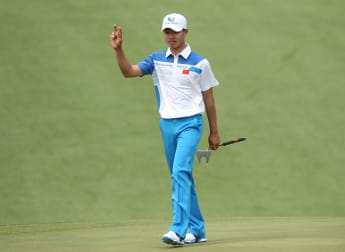As our celebrations of the 25th anniversary of the Challenge Tour continue, the Challenge Series spoke to Director Alain de Soultrait about the past, the present and the future of the tour…
Alain de Soultrait, Director of the Challenge Tour, on…
The beginning of the Challenge Tour
“Twenty-five years ago, there was a need for another tour to provide new playing opportunities to the many young professionals who want to join The European Tour.
“I think the success of the Challenge Tour is linked with the success of The European Tour. Without a strong European Tour there was no opportunity for success for the Challenge Tour, and The European Tour over the past 25 years has been extremely successful.
“Alongside the success of The European Tour, the Challenge Tour has progressed to where it is now.
“We had four main objectives. The first was to create a new path, an additional path for young players to join The European Tour in addition to the Qualifying School.
“The second objective was to create an environment where the best elite amateurs or the new pros could get some experience of life on the professional circuit.
“The third objective stemmed directly from the second one - to provide or create new, future stars for The European Tour and the European Ryder Cup team.
“The last one was to take golf to new countries and develop the game of golf anywhere we can.”
The success of the Challenge Tour
“Today we have 15 solid spots on The European Tour for graduates, so the top 15 in the Challenge Tour Rankings graduate to The European Tour, and this has been a great achievement.
“We have a strong schedule with 26 to 28 tournaments every year, which creates the perfect environment for young golfers to get experience and build up their skills so that when they reach the top, hopefully they know what life is about on The European Tour.
“We’ve had some very good results from former Challenge Tour players - 21 of them becoming Ryder Cup players, which is a fantastic achievement.
“We bring, or hope to bring, golf into new territories. I remember clearly when we first went to Russia 18 years ago. We’ve also been to Kazakhstan, we’ve been the first tour to bring professional golf to the Czech Republic and now we have tournaments in India and Kenya. This year we are bringing in two new countries to the Challenge Tour schedule in Ukraine and Oman.
“I think that is also part of the Challenge Tour’s responsibility, to develop golf within these countries.
“There is another figure that is very interesting, that 65% of players who currently have a card on The European Tour have played on the Challenge Tour.
“So it’s not only the cream of the crop that excels on The European Tour. With 21 players from Challenge Tour playing in The Ryder Cup, or 128 past winners on The European Tour, it’s also the strength in depth. This proves that the whole Challenge Tour system works.
“But again The European Tour being successful has helped the Challenge Tour to be successful and it’s all part of the same structure.”
The unearthing of golf superstars
“When the likes of Thomas Björn, Henrik Stenson and Martin Kaymer started on the Challenge Tour, they started to win early on so obviously they were good, and when they win several times in the same season it proved they were talented, dedicated and probably worked harder than some others to achieve better results.
“But the one point is that they are all very strong characters and I remember when they were young they had the same strength of character as they have today. So that’s probably one of the common characteristic with all of these successful players.
The alumni supporting Challenge Tour tournaments
“It’s always good to see former players from the Challenge Tour who have been successful giving something back to their country, because they have come through the amateur structure of each of their countries. To give something back to the Challenge Tour is very important recognition.
“As well as Thomas Björn, Henrik Stenson and Alex Cejka we’ve had Paul Lawrie support the Scottish Hydro Challenge and we’ve also had Marcel Siem support a tournament in Germany, so this is very important for us and can only help the Challenge Tour’s success.
Martin Kaymer’s Challenge Tour career
“I was not in Düsseldorf for his debut win, but I was at the Open de Volcans where he achieved his second win of the season. In between he had four top fives and he was outside the top ten for only two of his tournaments. Even then he was top 15!
“That’s quite a remarkable achievement and you could see he was a star, there was no doubt. He has been a tremendous example not only for German players but to all Challenge Tour players to show that this was possible.
“When I saw how good he was the following year on The European Tour and he started to win, that was a great signal and brought a lot of confidence to other Challenge Tour players.
“Obviously we are always proud to see a former player of the Challenge Tour achieve such incredible feats like being World Number One. And we are very proud to see 21 players, starting from Costantino Rocca down to Nicolas Colsaerts, being part of the European Ryder Cup team.”
The Challenge Tour’s influence on The Ryder Cup
“The Challenge Tour is there to produce the best players to represent Europe in The Ryder Cup, and in both 2010 and 2012 we’ve had five players in team.
“They are the important figures. We are fulfilling our obligation and our role in the European Golf structure.
The friendly atmosphere of the Challenge Tour
“These young players, many of whom have been playing against each other at the top amateur level, are playing together on the Challenge Tour.
“They are competitors but outside of that the camaraderie is very strong and it helps them to survive during the early years after turning pro. Sometimes it isn’t easy to find your way in professional life and a new tour is something completely different, so the camaraderie is very important on Challenge Tour.
The South African link and the growing internationality of the Challenge Tour
“The link between the South African players and The European Tour has always been evident, so when the Challenge Tour was created it was a natural path for the South African players.
“The first to achieve something great was Trevor Immelman, who won in Kenya in 2000 and graduated the same year, then went on to win the Masters in 2008.
“We have also started to see in the last couple of years more and more Americans playing on the Challenge Tour.
“This may have something to do with the restructure of the US PGA Tour, where from this year there won’t be any more Qualifying School places for the main tour. The only way is through the Web.com Tour.
“So some of the talented college players can see a quicker way to reach the top of professional golf by going through the Challenge Tour and then on to The European Tour.
“It can only strengthen the Challenge Tour because the more top young players we have, wherever they’re coming from, the better. It will also help the European players develop and help create a stronger tour.
The hopes and ambitions of the Challenge Tour
“It’s a big question. We must make sure we never forget what the Challenge Tour has been created for and make sure we achieve the four objectives we had.
“The opportunity is there to serve the young players, to help them be better players and at the end of the day that’s our mission and we have to stick with that mission.
“At The Ryder Cup in Medinah last year I had the chance to speak with the five players who played on the Challenge Tour. All these players were interested in how the Challenge Tour is doing, what we’re doing, how we’re progressing in these economic times. They keep an interest in the tour.
“They always remember where they have come from and I think it’s a great reward for the Challenge Tour.”







